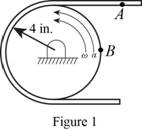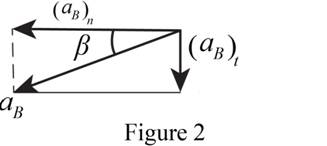
Concept explainers
(a)
Find the velocity and acceleration of point B just before the power is turned off.
(a)
Answer to Problem 15.19P
The velocity and acceleration of point B just before the power is turned off are
Explanation of Solution
Given information:
The initial speed
The radius (r) of the wheel is
The time taken (t) by the wheel and the chain coast to come to rest is
Consider the motion as uniformly decelerated motion.
Calculation:
Show the position of point A and B as shown in Figure 1.

Calculate the velocity of the point B just before the power is turned off using the relation:
Substitute
Thus, the velocity of the point B just before the power is turned off is
Calculate the uniform angular acceleration
The value of angular velocity
Substitute 0 for
Consider just before power is turned off.
The angular acceleration
Consider the normal and tangential component of the acceleration at point B are denoted by
Calculate the tangential component of acceleration of the point B using the relation:
Substitute
Calculate the normal component of acceleration of the point B using the relation:
Substitute
Neglect the effect of tangential acceleration as it is small.
Thus, the acceleration of point B just before the power is turned off is
(b)
Find the velocity and acceleration of point B just after 2.5 s.
(b)
Answer to Problem 15.19P
The velocity and acceleration of point B just after 2.5 s are
Explanation of Solution
Given information:
Calculation:
Refer Part (a).
Calculate the uniform angular velocity
The value of angular velocity
Substitute
Consider the time
Calculate the velocity of the point B using the relation:
Substitute
Thus, the velocity of point B just after 2.5 s is
Show the components of acceleration as shown in Figure 2.

Refer Figure 2.
Consider the normal and tangential component of the acceleration at point B are denoted by
Calculate the tangential component of acceleration of the point B using the relation:
Substitute
Calculate the normal component of acceleration of the point B using the relation:
Substitute
Calculate the angle
Neglect the effect of tangential acceleration as it is small.
Thus, the acceleration of point B just after 2.5 s is
Want to see more full solutions like this?
Chapter 15 Solutions
VEC MECH 180-DAT EBOOK ACCESS(STAT+DYNA)
- please help me to solve this problems first write the line of action and them find the forces {fx=0: fy=0: mz=0: and them draw the shear and bending moment diagram. please explain step by steparrow_forwardplease solve this problem step by step like human and give correct answer step by steparrow_forwardPROBLEM 11: Determine the force, P, that must be exerted on the handles of the bolt cutter. (A) 7.5 N (B) 30.0 N (C) 52.5 N (D) 300 N (E) 325 N .B X 3 cm E 40 cm cm F = 1000 N 10 cm 3 cm boltarrow_forward
- Using the moment-area theorems, determine a) the rotation at A, b) the deflection at L/2, c) the deflection at L/4. (Hint: Use symmetry for Part a (θA= - θB, or θC=0), Use the rotation at A for Parts b and c. Note that all deformations in the scope of our topics are small deformation and for small θ, sinθ=θ).arrow_forwardDistilled water is being cooled by a 20% propylene glycol solution in a 1-1/U counter flow plate and frame heat exchanger. The water enters the heat exchanger at 50°F at a flow rate of 86,000 lbm/h. For safety reasons, the water outlet temperature should never be colder than 35°F. The propylene glycol solution enters the heat exchanger at 28°F with a flow rate of 73,000 lbm/h. The port distances on the heat exchanger are Lv = 35 in and Lh = 18 in. The plate width is Lw = 21.5 2 in. The plate thickness is 0.04 in with a plate pitch of 0.12 in. The chevron angle is 30° and the plate enlargement factor is 1.17. All ports have a 2 in diameter. The fouling factor of the propylene glycol solution can be estimated as 2 ×10−5 h-ft2-°F/Btu. a. Determine the maximum number of plates the heat exchanger can have while ensuring that the water outlet temperature never drops below 35°F. b. Determine the thermal and hydraulic performance of the heat exchanger with the specified number of plates.…arrow_forwardLiquid pentane is flowing in the shell of a shell and tube heat exchanger at a rate of 350,000lbm/hr and an average temperature of 20°F. The shell has a diameter of 27 in and a length of 16ft. The tubes in the heat exchanger are ¾-in 15 BWG tubes on a 1-in triangular pitch. The purposeof this problem is to investigate how the number of baffles impacts the heat transfer and thepressure drop on the shell side of the heat exchanger. Calculate the shell-side convective heattransfer coefficient and pressure drop for the case where the heat exchanger has 10 baffles. Repeatthe calculation for 20 baffles. Then determine thea. Ratio of the shell-side convective heat transfer coefficient for the 20-baffle heat exchangerto the 10-baffle heat exchangerb. Ratio of the shell-side pressure drop for the 20-baffle heat exchanger to the 10-baffle heatexchangerc. If the optimum baffle spacing is somewhere between 0.4Ds and 0.6Ds, how many baffleswould you recommend for this heat exchanger? What are the…arrow_forward
- The evaporator of a vapor compression refrigeration cycle utilizing R-123 as the refrigerant isbeing used to chill water. The evaporator is a shell and tube heat exchanger with the water flowingthrough the tubes. The water enters the heat exchanger at a temperature of 54°F. The approachtemperature difference of the evaporator is 3°R. The evaporating pressure of the refrigeration cycleis 4.8 psia and the condensing pressure is 75 psia. The refrigerant is flowing through the cycle witha flow rate of 18,000 lbm/hr. The R-123 leaves the evaporator as a saturated vapor and leaves thecondenser as a saturated liquid. Determine the following:a. The outlet temperature of the chilled waterb. The volumetric flow rate of the chilled water (gpm)c. The UA product of the evaporator (Btu/h-°F)d. The heat transfer rate between the refrigerant and the water (tons)arrow_forwardThe blade support of a hacksaw is subject to compression when a blade is installed and tightened. What is the state of stress (total combined stress) at A in MPa if the compression in the support is 1,524 N. Note: pay close attention to what is compression and what is tension and use a negative sign for the former. 100 mm 8 mm 3 mm 75 mm A 8 mm 3 mm B 50 mmarrow_forwardThe answer is not 4.378 ft/sarrow_forward
- The answer is not 0.293 marrow_forwardplease first help me solve this problem find the line of action and them help to find the forces like for example {fx= fy= mz= and determine the shear force in the nailsarrow_forwardAn open channel of square cross section had a flowrate of 17.2 ft³/s when first used. After extended use, the channel became 0.6-filled with silt. Determine the flowrate for this silted condition. Assume the Manning coefficient is the same for all the surfaces. Qs= ! ft³/sarrow_forward
 Elements Of ElectromagneticsMechanical EngineeringISBN:9780190698614Author:Sadiku, Matthew N. O.Publisher:Oxford University Press
Elements Of ElectromagneticsMechanical EngineeringISBN:9780190698614Author:Sadiku, Matthew N. O.Publisher:Oxford University Press Mechanics of Materials (10th Edition)Mechanical EngineeringISBN:9780134319650Author:Russell C. HibbelerPublisher:PEARSON
Mechanics of Materials (10th Edition)Mechanical EngineeringISBN:9780134319650Author:Russell C. HibbelerPublisher:PEARSON Thermodynamics: An Engineering ApproachMechanical EngineeringISBN:9781259822674Author:Yunus A. Cengel Dr., Michael A. BolesPublisher:McGraw-Hill Education
Thermodynamics: An Engineering ApproachMechanical EngineeringISBN:9781259822674Author:Yunus A. Cengel Dr., Michael A. BolesPublisher:McGraw-Hill Education Control Systems EngineeringMechanical EngineeringISBN:9781118170519Author:Norman S. NisePublisher:WILEY
Control Systems EngineeringMechanical EngineeringISBN:9781118170519Author:Norman S. NisePublisher:WILEY Mechanics of Materials (MindTap Course List)Mechanical EngineeringISBN:9781337093347Author:Barry J. Goodno, James M. GerePublisher:Cengage Learning
Mechanics of Materials (MindTap Course List)Mechanical EngineeringISBN:9781337093347Author:Barry J. Goodno, James M. GerePublisher:Cengage Learning Engineering Mechanics: StaticsMechanical EngineeringISBN:9781118807330Author:James L. Meriam, L. G. Kraige, J. N. BoltonPublisher:WILEY
Engineering Mechanics: StaticsMechanical EngineeringISBN:9781118807330Author:James L. Meriam, L. G. Kraige, J. N. BoltonPublisher:WILEY





